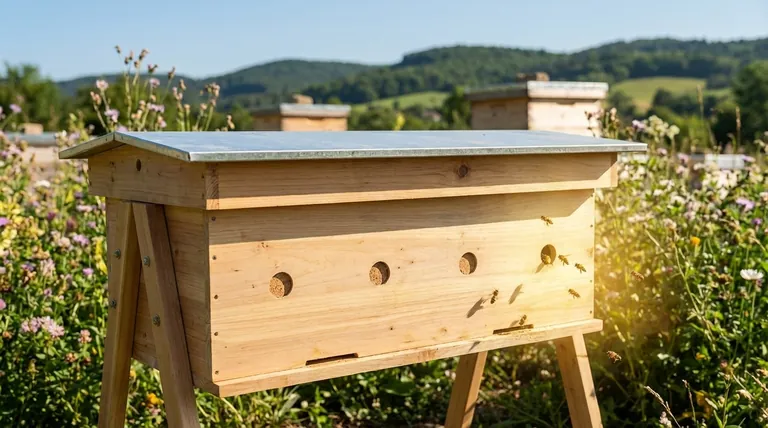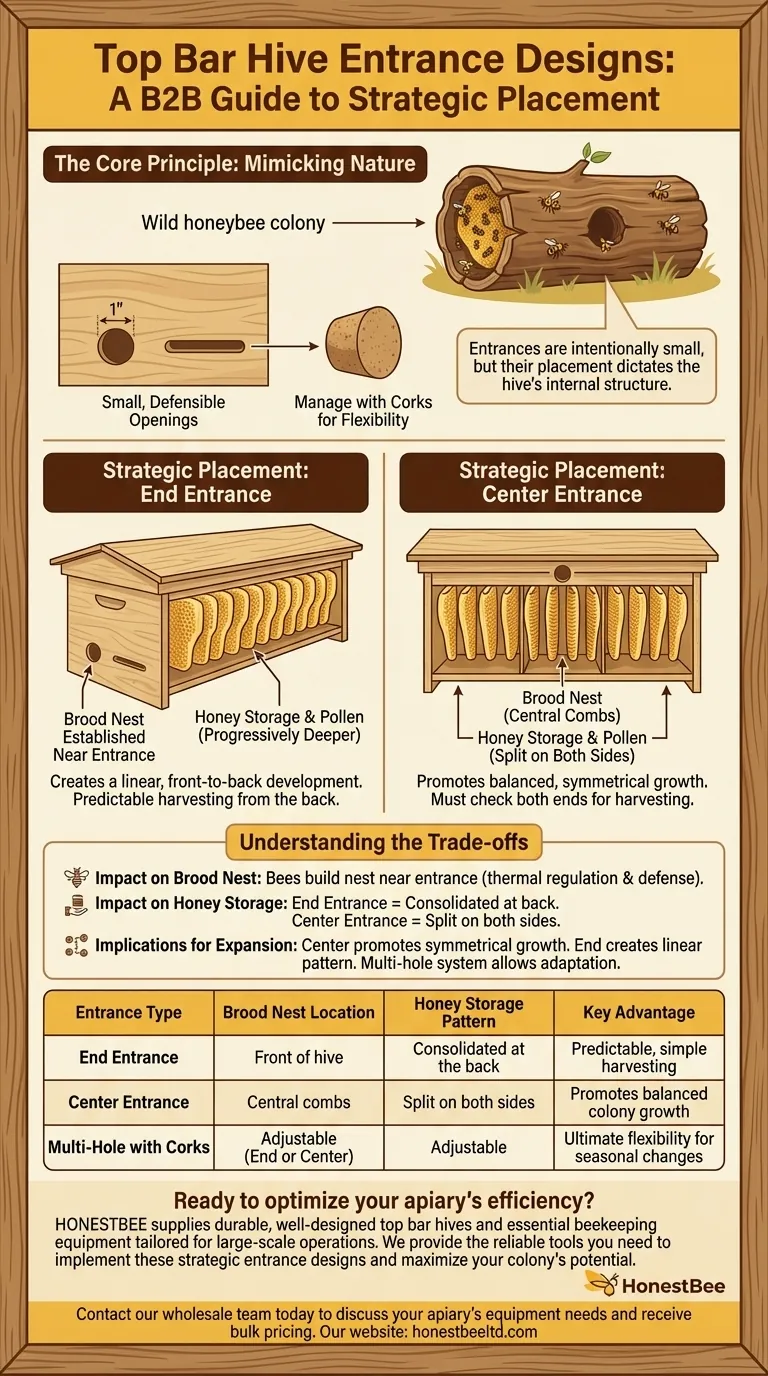In top bar hives, entrances are intentionally small, but their placement is the most critical design decision a beekeeper makes. Entrances are typically designed as a series of 1-inch diameter holes or small slots, which can be opened or closed to strategically influence the hive's internal structure. This placement directly dictates where the bees will establish their brood nest and, consequently, where they will store their honey.
The location of the entrance is not a minor detail; it is the primary tool for shaping the entire layout of the colony. By choosing an entrance at the end or in the center of the hive body, you determine whether honey is stored in one consolidated area or split on either side of the brood.

The Core Principle: Mimicking Nature
The design of a top bar hive entrance is rooted in emulating the small, defensible openings that honeybee colonies prefer in the wild. This principle guides both the size and configuration.
Size and Shape
Entrances are most often a series of circular holes, approximately 1 inch in diameter, or a narrow horizontal slot of a similar area.
This small size is easier for the guard bees to defend against pests like wasps and robbing bees from other colonies.
Managing Entrances with Corks
A common and highly effective method involves drilling multiple potential entrances along the hive body. Typically, this includes three holes in the center and one at each end.
Corks or plugs are then used to close off the holes you do not want the bees to use. This provides excellent flexibility, allowing you to change the hive's configuration as the colony grows or as seasons change.
Strategic Placement: End vs. Center
The choice of where to locate the primary entrance fundamentally organizes the colony's internal life. The queen will almost always establish the brood nest (where she lays eggs and young bees are raised) nearest to the active entrance.
The End Entrance Design
Placing the entrance at one of the narrow ends of the hive is a popular and straightforward approach.
In this configuration, the brood nest is established at the front of the hive, near the entrance. The bees will then store honey and pollen in the combs progressively deeper into the hive, towards the back end.
The Center Entrance Design
Alternatively, the entrance can be placed in the middle of one of the long sides of the hive.
This causes the colony to create its brood nest in the center combs. Honey is then stored on the combs on both sides of the central brood area, expanding outwards toward each end of the hive.
Understanding the Trade-offs
Your choice of entrance placement has direct consequences for hive inspections and honey harvesting. Neither is inherently superior, but they create different management workflows.
Impact on Brood Nest Location
The unbreakable rule is that bees build the brood nest near the entrance. This is for thermal regulation and defense. Understanding this allows you to know exactly where the most sensitive part of the colony is located before you even open the lid.
Impact on Honey Storage
With an end entrance, honey harvesting is predictable: you always work from the back of the hive, furthest from the brood.
With a center entrance, you must check both ends of the hive for harvestable honey, as it will be stored on either side of the central brood chamber.
Implications for Hive Expansion
A central entrance can be seen as promoting more symmetrical expansion of the colony. An end entrance creates a more linear, front-to-back development pattern. The multi-hole system allows you to adapt this as needed, for instance, by opening end holes in summer to improve ventilation.
Choosing the Right Entrance Strategy
Your decision should be based on your management style and goals for the hive.
- If your primary focus is a simple, predictable harvest: Use an end entrance design, as your honey will always be consolidated at the back of the hive.
- If your primary focus is flexibility and balanced hive growth: Use a center entrance or a multi-entrance system with corks to adapt to the colony's needs.
By thoughtfully designing the entrance, you gain significant control over the development and management of your top bar hive.
Summary Table:
| Entrance Type | Brood Nest Location | Honey Storage Pattern | Key Advantage |
|---|---|---|---|
| End Entrance | Front of hive | Consolidated at the back | Predictable, simple harvesting |
| Center Entrance | Central combs | Split on both sides | Promotes balanced colony growth |
| Multi-Hole with Corks | Adjustable (End or Center) | Adjustable | Ultimate flexibility for seasonal changes |
Ready to optimize your apiary's efficiency?
As a commercial beekeeper or distributor, proper hive design is critical for productivity and honey yield. HONESTBEE supplies durable, well-designed top bar hives and essential beekeeping equipment tailored for large-scale operations.
We provide the reliable tools you need to implement these strategic entrance designs and maximize your colony's potential.
Contact our wholesale team today to discuss your apiary's equipment needs and receive bulk pricing.
Visual Guide

Related Products
- Long Langstroth Style Horizontal Top Bar Hive for Wholesale
- HONESTBEE Professional Long Handled Hive Tool with Precision Cutting Blade
- Top Bar Beehive for Beekeeping Wholesales Kenya Top Bar Hive
- HONESTBEE Professional Multi-Functional Hive Tool with Ergonomic Wood Handle
- HONESTBEE Advanced Ergonomic Stainless Steel Hive Tool for Beekeeping
People Also Ask
- What are the main differences between Langstroth hives and top bar hives? Choose the Right Hive for Your Beekeeping Goals
- What are the benefits of the top bar hive? A Guide to Ergonomic, Natural Beekeeping
- What are the benefits of a top bar hive? A Natural, Low-Impact Approach to Beekeeping
- How does the top bar hive help control varroa mites? A Natural Approach to Mite Management
- What are the most popular types of hives besides the Langstroth? Top Bar & Horizontal Hives Explained



















